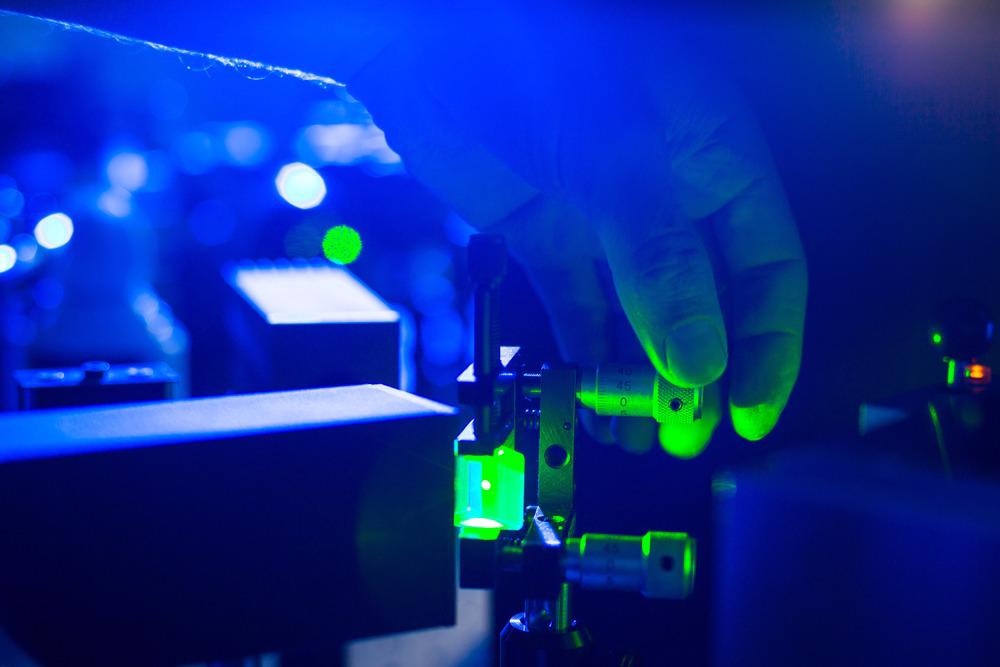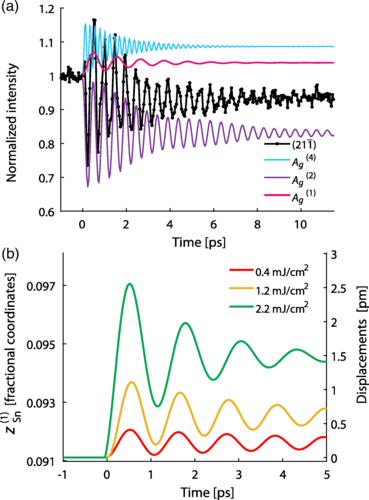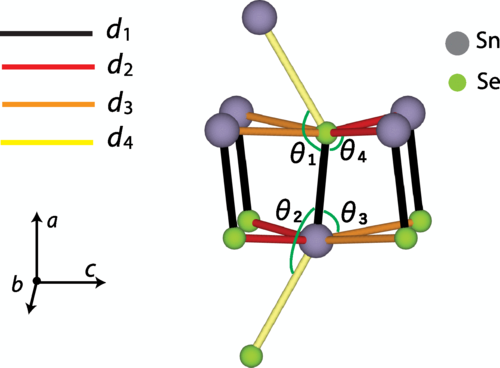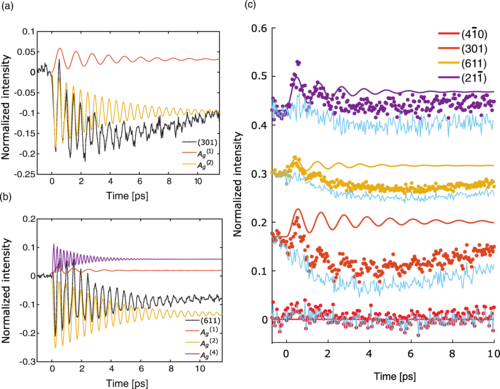In a recent study published in the open-access journal Physical Review X, researchers analyzed nonequilibrium states of functionalized materials that can only be induced by above bandgap photoexcitation using ultrafast laser pulses, and not by thermal excitation.

Study: Observation of a Novel Lattice Instability in Ultrafast Photoexcited SnSe. Image Credit: l i g h t p o e t/Shutterstock.com
Monochalcogenides such as tin selenide (SnSe) pass through a lowest-frequency Ag phonon softening phase while thermally driven into a phase with a Cmcm structure. They found that this soft mode is actually accompanied by a different lattice structure with Immm symmetry. This can enable optical tuning of ferroelectric, thermoelectric, and topological properties of monochalcogenides.

(a) Decomposition of the (211) time-resolved diffraction signal at a nominal absorbed fluence of 0.8 mJ/cm2 (b) Time dependence of z(1)Sn, the Sn z position projected onto the Ag(1) mode, as calculated from the (211 ) peak measured under different nominal absorbed fluences. z(1)Sn is defined in fractional coordinates. The right y axis shows the corresponding displacements in picometers (pm). Image Credit: Huang, Y et al., Physical Review X
Background
XIV-XVI monochalcogenides compounds have delicate energy barriers that separate a large number of nearly degenerate material phases. The energy balance between these phases can be destabilized using an external energy source to achieve tunable ferroelectric, thermoelectric, and topological properties.
Theoretically, SnSe has a rocksalt structure, but under ambient conditions, it has a centrosymmetric orthorhombic Pnma structure. SnSe undergoes a thermally driven second-order phase transition at high pressure (10.5 GPa) or temperature (807 K) to a higher-symmetric orthorhombic Cmcm structure.
Furthermore, photoexcitation of SnSe by ultrafast laser pulses pushes electrons and holes above the energy bandgap, followed by quick relaxation. This results in a quasi-equilibrium electronic distribution. The effect of ultrafast excitation induces lattice instability that is different from thermally driven excitation. Further investigation is required into the Immm phase induced by ultrafast pulse laser excitation.
About the Study
In this study, researchers tried to analyze the nonequilibrium state of SnSe induced by ultrafast laser pulses. The photons of a near-infrared (NIR) Ti:saphire laser with an energy of 1.55 eV were further energized by X-ray probe pulses with a photon energy of 9.5 keV to achieve ultrafast pulses. A diamond (111) double-crystal monochromator was used to make coherent X rays with a nominal flux of more than 109 photons per pulse.
The X-rays had an incident angle of 0.5⁰ with respect to the sample surface, whereas the NIR laser beam had an incident angle of 1⁰. Hence, the penetration depth of both beams matched perfectly from two angles. The nominal absorbed fluence was 0.8 mJ/cm2.

Pnma SnSe bonds and bond angles. Image Credit: Huang, Y et al., Physical Review X
Observations
From Raman measurements of the spectral amplitude vs. frequency graph, it is evident that there were three modes of excitation at 0.9, 2, and 4.5 THz, denoted as Ag(1), Ag(2), and Ag(4) modes, respectively. The Ag(1) displacements were due to shearing between bilayers along the c-axis, whereas Ag(2) primarily affected the buckling of the bilayer by displacing Se and Sn from the same atomic layer in the opposite direction along the a-axis. The Ag(3) and Ag(4) displacements were similar to that of Ag(1) and Ag(2), respectively, except that the π electrons of the Sn atoms were out of phase.
The Ag(1) phonon mode became unstable near the transition temperature of the Pnma-Cmcm phase at 807 K. The frequency of the Ag(1) mode decreased/softened by 20% at the highest nominal absorbed fluence of 2.2 mJ/cm2, whereas the Ag(2) and Ag(4) modes softened by less than 4%. Moreover, the Ag(1) phonon mode displaced the rocksalt lattice of SnSe at 807 K further away from the Cmcm structure.
The Pnma-Immm lattice transition was associated with restorations of high-symmetry positions along the c- and a-axes, and atomic displacements along the Ag(1) and Ag(2) coordinates, respectively. Moreover, the constrained density functional theory (cDFT) measurement indicated that the Sn atoms displaced toward the Immm structure instead of the Cmcm structure.

(a) Linear prediction showing decomposition of modes for peak (611), and similarly (b) for peak (301). The black traces are the raw data, and the colored traces are the components of Ag modes. (c) Color dots represent the residual of raw data after subtracting off the Ag(2) and Ag(4) components; the solid color lines represent the Ag(1) component. Image Credit: Huang, Y et al., Physical Review X
Conclusions
To conclude, the researchers of this study analyzed the nonequilibrium state of SnSe induced by ultrafast laser pulses, which could not be achieved through a high-temperature phase transition from Pnma to Cmcm at 807 K. The new pseudoequilibrium phase, Immm, was a result of the relaxation of above bandgap excited electrons into high-symmetry positions along the Ag(1) and Ag(2) displacements.
This mechanism can be practically exercised to optically control the ferroelectric, thermoelectric, and topological properties of monochalcogenides.
Disclaimer: The views expressed here are those of the author expressed in their private capacity and do not necessarily represent the views of AZoM.com Limited T/A AZoNetwork the owner and operator of this website. This disclaimer forms part of the Terms and conditions of use of this website.
Source:
Huang, Y., Yang, S., Teitelbaum, S., De la Peña, G., Sato, T., Chollet, M., Zhu, D., Niedziela, J., Bansal, D., May, A., Lindenberg, A., Delaire, O., Reis, D., Trigo, M., Observation of a Novel Lattice Instability in Ultrafast Photoexcited SnSe. Physical Review X, 2022, 12, 011029: https://journals.aps.org/prx/abstract/10.1103/PhysRevX.12.011029